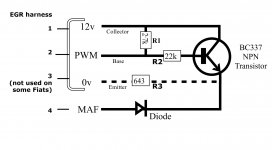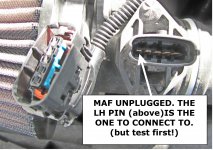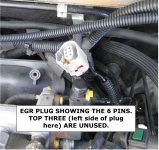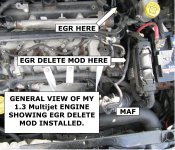Sweetsixteen
Established member
- Joined
- Jul 7, 2014
- Messages
- 1,109
- Points
- 204
If you have a diesel, there are two ways to get rid of the unloved EGR. Blank it - which on the Multijet is a real pain, or keep it closed electronically. I’ve done the latter, and here is how I did it.
I am not the originator of this idea. It has been around for years. I first used it on a Merc 5 cylinder diesel, then on my present Merc which has now clocked over 150k miles, and recenty on my Panda Multijet. I’ve modified the circuitry, and the results may not be the slickest because I am no auto-electric whizkid, but they are simple enough and work faultlessly.
Before you read on, here is my disclaimer. If you do this it’s entirely at your own risk and I am not responsible if you mess up or if it doesn’t work on your vehicle.
The cost is peanuts - all the components can be bought for less than a fiver total - and it can all be done with clean hands and easy access under the bonnet.
The mod involves making up a small circuit (see diagram and photos) and wiring it into the Maf/Egr loop. Its purpose is to fool the ECU into believing the EGR is working when in fact it stays shut and out of use.

HOW TO:
THE CIRCUIT.
Look at the diagram and make up the circuit by soldering all the components together as shown. It looks complicated at first sight, but in fact it is very easy with a bit of patience. Make sure the transistor is wired the right way round, and the diode also. The circuit will not work if either are incorrectly wired. R1, R2 and R3 refer to the resistor values listed below.
You will need:
2.7k ohms resistor.
22k ohms resistor.
BC337 NPN Transistor.
Diode.
Option on some EGR’s only - not needed for 1.3 Multi, which is why it’s a dotted line on the diagram - 643 ohms resistor (in practice there is no 643 ohm resistor, so soldering, say, 560 and 82 ohm resistors together in series does the job).
You can get these components from Maplins or from Bright Components on Ebay.
I made my Merc one to fit into a discarded credit card holder. The Fiat one I just heat-shrunk together once I’d soldered it up. See photos.
MAF.

Wire No 4 is spliced into the wire attached to the end pin of the MAF plug (furthest away from the cable on the plugtop). Double-check that you have the right wire by running the engine and measuring the voltage at the pin with a multimeter. It should read around 1.8 - 2.2 volts at idle. This is the signal wire. It’s easier to do this if you pull the plug off the MAF then unsnap the top of the plug, which will expose the five wires of the MAF. I didn’t wire directly into the plug, but cut the wire further down the harness and used an inline crimp connector to piggyback. My wire was brown, but always check as above. Reconnect the MAF plug once this is done, because the MAF signal is always needed.
EGR.

Unplug the EGR. The plug on the harness will have two rows of three pins. The top row is unused, leaving you just the lower three pins to choose from. Check the voltage on each. One should read 12 volts, another 0 volts and the third, which is the pwm signal (pulse width modulation) will vary, but should hover around 3 volts. Follow the diagram and connect Wire No 1 to 12volt, Wire No 2 to pwm, by splicing into the harness.
LEAVE THE EGR UNPLUGGED - it is no longer operational and will remain closed.
It really is that simple. Fire up and test. Enjoy the results.


A few pointers:
Pull the EGR plug and check the wiring BEFORE starting to make the mod. This is where the dotted line comes in on the diagram. Some EGR’s have only two wires, so Wire No 3 would not be used. If the EGR has only two wires, then forget Wire No 3 and its resistors. This wire will not be needed.
Study the photos - they will help.
Weatherproof all wires and the exposed EGR connection.
Cable tie everything so that your mod does not flap about as you drive.
Hope this is useful to you diesel owners.
I am not the originator of this idea. It has been around for years. I first used it on a Merc 5 cylinder diesel, then on my present Merc which has now clocked over 150k miles, and recenty on my Panda Multijet. I’ve modified the circuitry, and the results may not be the slickest because I am no auto-electric whizkid, but they are simple enough and work faultlessly.
Before you read on, here is my disclaimer. If you do this it’s entirely at your own risk and I am not responsible if you mess up or if it doesn’t work on your vehicle.
The cost is peanuts - all the components can be bought for less than a fiver total - and it can all be done with clean hands and easy access under the bonnet.
The mod involves making up a small circuit (see diagram and photos) and wiring it into the Maf/Egr loop. Its purpose is to fool the ECU into believing the EGR is working when in fact it stays shut and out of use.

HOW TO:
THE CIRCUIT.
Look at the diagram and make up the circuit by soldering all the components together as shown. It looks complicated at first sight, but in fact it is very easy with a bit of patience. Make sure the transistor is wired the right way round, and the diode also. The circuit will not work if either are incorrectly wired. R1, R2 and R3 refer to the resistor values listed below.
You will need:
2.7k ohms resistor.
22k ohms resistor.
BC337 NPN Transistor.
Diode.
Option on some EGR’s only - not needed for 1.3 Multi, which is why it’s a dotted line on the diagram - 643 ohms resistor (in practice there is no 643 ohm resistor, so soldering, say, 560 and 82 ohm resistors together in series does the job).
You can get these components from Maplins or from Bright Components on Ebay.
I made my Merc one to fit into a discarded credit card holder. The Fiat one I just heat-shrunk together once I’d soldered it up. See photos.
MAF.

Wire No 4 is spliced into the wire attached to the end pin of the MAF plug (furthest away from the cable on the plugtop). Double-check that you have the right wire by running the engine and measuring the voltage at the pin with a multimeter. It should read around 1.8 - 2.2 volts at idle. This is the signal wire. It’s easier to do this if you pull the plug off the MAF then unsnap the top of the plug, which will expose the five wires of the MAF. I didn’t wire directly into the plug, but cut the wire further down the harness and used an inline crimp connector to piggyback. My wire was brown, but always check as above. Reconnect the MAF plug once this is done, because the MAF signal is always needed.
EGR.

Unplug the EGR. The plug on the harness will have two rows of three pins. The top row is unused, leaving you just the lower three pins to choose from. Check the voltage on each. One should read 12 volts, another 0 volts and the third, which is the pwm signal (pulse width modulation) will vary, but should hover around 3 volts. Follow the diagram and connect Wire No 1 to 12volt, Wire No 2 to pwm, by splicing into the harness.
LEAVE THE EGR UNPLUGGED - it is no longer operational and will remain closed.
It really is that simple. Fire up and test. Enjoy the results.


A few pointers:
Pull the EGR plug and check the wiring BEFORE starting to make the mod. This is where the dotted line comes in on the diagram. Some EGR’s have only two wires, so Wire No 3 would not be used. If the EGR has only two wires, then forget Wire No 3 and its resistors. This wire will not be needed.
Study the photos - they will help.
Weatherproof all wires and the exposed EGR connection.
Cable tie everything so that your mod does not flap about as you drive.
Hope this is useful to you diesel owners.



